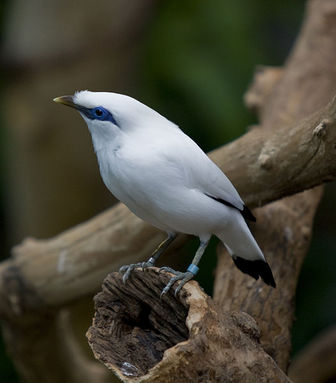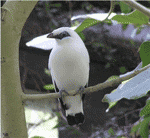Bali Myna
Placed in the monotypic genus Leucopsar, it appears to be most closely related to Sturnia and the Brahminy Starling which is currently placed in Sturnus but will probably soon be split therefrom as Sturnus as presently delimited is highly paraphyletic . The specific name commemorates the British ornithologist Lord Rothschild.

Original source: IMG_3469Uploaded by Snowmanradio
Author: Brian from Chicago, United States
 The Bali starling (Leucopsar rothschildi) is a quite "new" bird species. It is known to science since 1912 when it was described by the ornithologist Erwin Stresemann, who had found it one year before during an excursion. The natural distribution range of this starling is restricted to the island of Bali, a part of Indonesia nowadays. The birds inhabit monsoon forests and acacia savannas. They reach lengths up to 25 cm and weights up to 90 g. Bali starlings feed on all sorts of insects, most of all ants, termites and caterpillars. Fruits and seeds are part of their diet too. They prefer old woodpecker holes for their nests. Males tend to be very aggressive during the breeding season. Outside of the breeding season Bali starlings previously lived in flocks consisting of up to 40 individuals. But the emphasis is on "previously" since the entire population living in the wild is less than 40 birds at the moment.
The Bali starling (Leucopsar rothschildi) is a quite "new" bird species. It is known to science since 1912 when it was described by the ornithologist Erwin Stresemann, who had found it one year before during an excursion. The natural distribution range of this starling is restricted to the island of Bali, a part of Indonesia nowadays. The birds inhabit monsoon forests and acacia savannas. They reach lengths up to 25 cm and weights up to 90 g. Bali starlings feed on all sorts of insects, most of all ants, termites and caterpillars. Fruits and seeds are part of their diet too. They prefer old woodpecker holes for their nests. Males tend to be very aggressive during the breeding season. Outside of the breeding season Bali starlings previously lived in flocks consisting of up to 40 individuals. But the emphasis is on "previously" since the entire population living in the wild is less than 40 birds at the moment.
The population of the Bali starling has never been large but it has been estimated to several hundreds individuals in the not too distant past. The situation became most dramatic in 1990 when just 13 individuals were found in the wild. The decrease of the population already started shortly after the Bali starling was detected. The white plummage, the black wings and the blue area around the eyes made the birds highly attractive to the cage-bird trade. And the rarer they became the more attractive they were to certain collectors. Another reason for their decrease was man-made changes to their natural habitat raising competition of another starling species which was more able to cope with the new circumstances.
The Bali starling is protected by Indonesian law nowadays. It's distribution range is limited to the Bali Barat National Park, where the birds are guarded by armed personel. The wild population has been enlarged by birds bred in captivity but is still not larger than 32 individuals (estimated in 1999). Bali starlings are bred in zoos and bird parks. The captivity population consists of about 700 birds. But breeding only makes sense if it is possible to stabilize the population in the wild. The European breeding programme is coordinated by Cologne zoo. The in-situ-project on the island of Bali is supported by the Brehm Fonds of Walsrode bird park in northern Germany.
This article was originally published at magazine.naturspot.de. Link to the original article
Picture of Bali Myna, originally uploaded to Dutch wikipedia by user Jcwf; photographed by himself
Permission is granted to copy, distribute and/or modify the picture of Bali Myna under the terms of the GNU Free Documentation License, Version 1.2 or any later version published by the Free Software Foundation; with no Invariant Sections, no Front-Cover Texts, and no Back-Cover Texts.
Subject to disclaimers.
The Bali Myna is classified as Critically Endangered (CR), facing an extremely high risk of extinction in the wild.

Original source: David Bygott
Author: David Bygott
Permission: Some rights reserved
Family : Sturnidae
Genus : Leucopsar
Species : rothschildi
Authority : Stresemann, 1912
